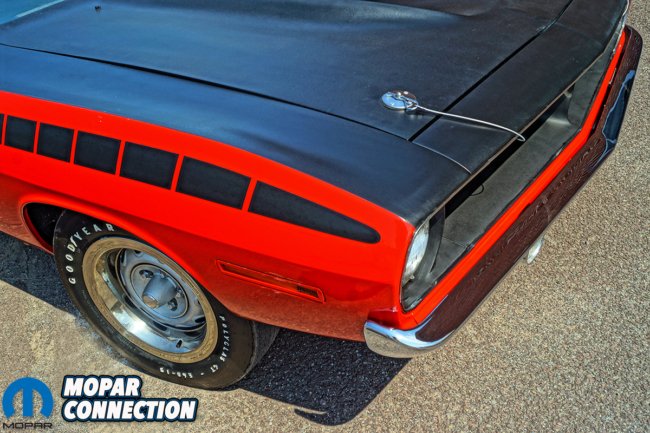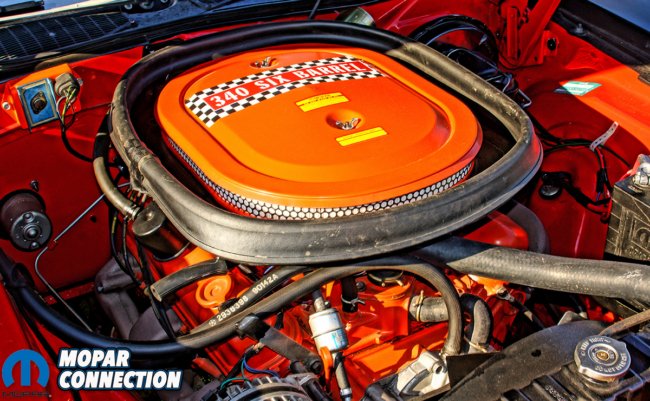
In 1966, when the SCCA Trans-American Sedan Championship for Manufacturers Series (later known as the Trans-Am Series) formed, there was an expectation that the manufacturers would race assembly line constructed cars. However, as the Trans-Am Series matured, the manufacturers began engineering hand-made cars that were race-only designs in an attempt to beat the competition. As a result of these actions, the Trans-Am Series initiated new regulations.
These rules forced the manufacturers to build and sell a specific number of vehicles to the public that were significantly similar to the race version. By 1970, the Chrysler brass, no longer content with Ford Mustangs and Chevrolet Camaros dominating the 5.0-liter class in the Trans-Am Series, decided to bomb the class with new offerings from Plymouth and Dodge. To satisfy the series requirements, street versions of the Plymouth ‘Cuda AAR, and its sibling, the Dodge Challenger T/A, were offered to the public.

To guarantee the ’70 Plymouth ‘Cuda was legal for the Trans-Am Series, the construction of 2,500 units was necessary. The AAR was produced from March 10 until April 17 of 1970, and 2,724 AARs were produced (1,120 equipped with an A-833 4-speed transmission and 1,604 being furnished with a TorqueFlite). Chrysler team manager, Pete Hutchinson, hired Keith Black to build the engines, while Dan Gurney’s company, All-American Racers, was commissioned to rework the ‘Cuda AAR uni-bodies. The series required a factory block and heads with an engine displacement no larger than 305 cid fitted with a single four-barrel carburetor. A destroked 340 was coupled to a pair of cast iron heads with angled intake pushrods and offset intake rocker arms, which allowed larger intake ports.
To be legal for the series, the race version of the AAR had to retain the body dimensions and appearance of the production version. The racecar benefitted from front and rear spoilers and a hood scoop, and thus, the street version came equipped with them. The street edition of the ‘Cuda received a detuned version of the race engine, but the displacement was 340cid, and it was fitted with three Holley two-barrel carburetors atop an Edelbrock intake manifold. To guarantee the street adaptation had a racy look and sound, a low-restriction, side-dump exhaust was installed, which propelled the 340 to 290 horsepower at 5000 RPM and 335 lb/ft of torque at 3400 RPM.
The story of how Jack Reese, of Conyngham, Pennsylvania, found this ‘Cuda AAR is an interesting escapade in patience, persistence, and a bit of luck. In 2007, Reese, a career elementary school teacher (now retired), had a chance meeting with a former student. Reese hired the student to complete a small project around the house. Upon completion, a conversation arose about a ‘Cuda located near Reese’s residence. Although Reese had some interest, nothing came of the conversation. Fast forward to January 2013, Reese again spoke with his former student about the ‘Cuda.
While the AAR was still available, Reese continued to waffle about the car until Bonnie, Reese’s wife, suggested pursuing the ‘Cuda. With his wife’s blessing, Reese reached out to the seller several times, but the seller seemed determined to be unavailable. Finally, in April 2013, Reese connected with the owner and viewed the ‘Cuda. Upon seeing the AAR, Jack got his finances in order to purchase the ‘Cuda, but as fate would have it, the negotiations stalled. Not one to give up, Reese continued his attempts to work out a deal. It took several months to finalize the transaction, but in the end, Reese beat out all of the interested parties, and in July 2013, he became the AAR’s fourth owner.

After the purchase, Reese tracked down the history of the AAR. It was purchased from Stephen Butcher Chrysler Plymouth in Hazelton, PA in 1970. By 1971, the ‘Cuda was sold to the second owner, and it was passed to a third owner in 1973. Reese purchased the 56.5K-mile AAR in 2013, but the AAR had been stored since 1978. The un-drivable ‘Cuda was in boxes, and the larger pieces unable to fit into those boxes were strewn about the garage. Upon delivery to Reese’s home, an inventory of the ‘Cuda was started to determine which parts remained, and which had been lost or damaged.
Reese’s AAR was assembled at the Hamtramck, Michigan assembly plant on April 10, 1970, and it was fitted with the A53 Trans Am Package that included a six-barrel 340 engine connected to a New Process 833 4-speed transmission and a 3.55:1 geared 8 ¾-inch rear end. The exterior was painted in the popular color, Bright Red (FE5 – Rallye Red). The interior had the high-line trim that included black colored bucket front seats, back seat, and door panels. The AAR was equipped with power brakes, a rallye instrument cluster package, an outside left-hand remote racing mirror, hood tie down pins, a duck wing rear spoiler, roof drip rail moldings, side exhaust, deck lid molding treatment, tachometer, a fiberglass fresh air hood, a two-watt AM radio, longitudinal stripes in black, and a 26” radiator. Strangely the front eyebrow spoilers were not ordered on this AAR.
Starting the restoration, Reese transported the ‘Cuda’s chassis to a body shop located in McAdoo, PA, where an 81-year-old body man worked his magic to repair the lower quarter panels with fresh metal. An NOS passenger side fender replaced the crumbled unit. The entire body was sprayed with several layers of the factory-tinted Rallye Red base coat. The red hue was encapsulated in numerous layers of clear. The results of the labor provided phenomenal bodylines that are crisp and straight covered in a deep and vibrant red color.
While the car was out for bodywork and paint, the engine was sent to Burns and Yost Machine Service of New Ringgold, PA. Sticking with the age and experience angle, Jack had the 340 rebuilt to factory specifications by the pair of senior citizens (74 & 75 years of age). The engine was in great condition; it required a good cleaning and minimal machining to bring it back to the factory specifications. Factory NOS parts were found to replace the water pump, PCV, plug wires, and the plugs. After a few coats of OEM orange paint, the 340 was ready for the final assembly by the employees at Burns and Yost.

As a result of being off the road for decades, the New Process 4-speed transmission and 8 ¾” Sure-grip had acquired limited miles and each was in excellent condition. Just like the engine, the transmission and rear differential were cleaned and adjusted to stock specs. The driveshaft u-joints were replaced with NOS parts and installed on the balanced driveshaft. The rear leaf springs were quite saggy, so a new pair of leaf springs was slipped under the AAR. Each of the components were sprayed in the factory black, silver, or left bare as the factory had done. The brake calipers were rebuilt, as were the rear wheel cylinders. In all instances, a slew of NOS and Year One parts were installed in place of the originals.
The dash pad and door panels were in great shape; only a good cleaning was necessary to bring back the factory luster. The front and rear seats were disassembled, and the front seat frames were media blasted and repainted. New seat foam was placed on the seat frames, and the seats were recovered with seat covers from Legendary Auto Interiors. The dash was dyed in black, while the gauges and selectors were given some attention to ensure they worked correctly and looked fantastic.

Before all the exterior components were installed, the hood, top of the fenders, and the tops of the doors were sprayed in the factory Organasol (a black textured paint). The chrome pieces of the AAR required a re-chroming by Librandi’s Plating of Middletown, PA. The Rallye Wheels were media blasted and reshot in Argent silver. Completing the wheels was NOS wheel hardware, which included the trim rings, the center caps, and the matching lug nuts.
Wrapping the Rallye Wheels was a pair of E60 front tires and a pair G60 rear tires. The tires were reproductions from Coker Tires of the original Goodyear Polyglas hoops that the AAR had when it left the assembly line in 1970. Reproduction strobe stripes were lined up and installed on each side of the AAR. With the addition of the driver’s side exterior mirror and the duck wing rear spoiler, the exterior was nearly finished.
The AAR’s odometer now registers almost 57,400 miles. Reese still wants to address a few things, such as painting the fender bolts in the correct black color, using the correct plastic buckets on the fog light wiring, and focusing on a few minor brake-related concerns. While Dan Gurney’s 1970 ‘Cudas may be a distant memory and merely a footnote in the history of the Trans-Am Series, it was the sanctioning body’s requirements for strict adherence to the assembly of production cars that leaves us with this AAR, an All-American Racer in Rallye Red.




















































A very good article Chris, How do you get featured in your magazine.I have a few Mopars.
Thank You
Mike
Michael, please email me directly at kevin.shaw@shawgroupmedia.com with what cars you have that you think are worth featuring!